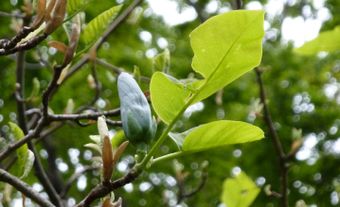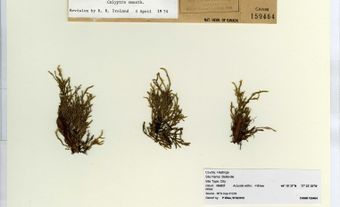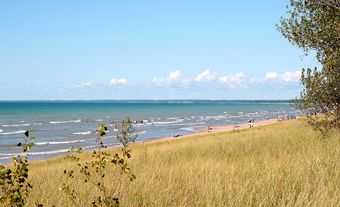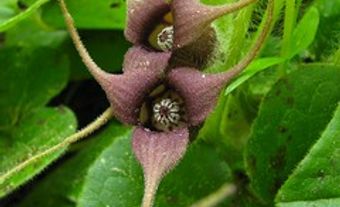The pawpaw (Asimina triloba) is a shrub or small tree of the Annonaceae, or custard-apple, family. It is the only member of the custard-apple family that grows in Canada. Sometimes called dog-banana, the pawpaw’s fruit is edible. It is believed that Indigenous people, including the Erie and Onondaga, introduced the tree to Southern Ontario from the United States. The plant is a beautiful ornamental shrub due to its large leaves and red-purplish flowers. Recently, this small tree has attracted the attention of researchers as a potential anticancer drug alternative.

Description
The name pawpaw means papaya in Arawak (a language spoken by Indigenous people in South America), though papaya trees are unrelated to pawpaw trees. The pawpaw is a small tree or shrub that rarely grows to more than 15 m in height. The trunk is slender and the bark on older trees has shallow furrows. The membranous leaves can be quite long, expanding up to 40 cm when including the stalk that attaches the leaf to the branch. The leaves are hairy when young, becoming smooth as they age. Pawpaw flowers are maroon to purplish in colour, and can reach up to 5 cm in diameter. They emit an unpleasant odor that attracts flies and beetles for pollination. The flowers are borne singly on last year branches from a drooping stalk called nodding peduncle, and appear at the same time as leaves. The fruit is a kidney shaped, yellow-green berry, turning brownish when ripe. The plant produces numerous suckers from its roots, meaning new trees are likely come from one individual. Some foresters see the pawpaw as a problem as it can occupy all of a forest’s understory space, leaving little room for native plants.
Distribution and Habitat
The pawpaw thrives in rich soils, often near rivers. Barely reaching Southern Ontario in Canada, this shrub or small tree grows primarily in the Eastern United States. Indigenous people are thought to have introduced pawpaws to Southern Ontario and western New York. In history of New France, published in 1744, Pierre-François-Xavier de Charlevoix, wrote that the Erie, a First Nation member of the Iroquoian family, were responsible for the small tree in Canada, possibly transplanting seeds from fruit harvested south of Allegheny County, Pennsylvania. Similarly, Paul Le Jeune, a Jesuit priest, wrote that the Onondaga Nation, part of the Haudenosaunee Confederacy, introduced it after a war with the Erie.
The pawpaw was also a trading item among multiple Indigenous groups. The fact that trees are found along major Indigenous trade routes is further evidence that First Nations shaped the pawpaw’s present-day distribution.

Pollination and Harvesting
Flowers appear during spring, and the number of fruit is dependent on pollination occurring or not. Fruit dispersal seems to be by water (fruit and seeds float, and water can move them far from the mother tree) and by animals (birds, foxes, opossums, raccoons, and squirrels).
The pawpaw has gained interest as a fruit crop. Many nurseries in Canada and United States offer the plant as an ornamental tree or shrub. There are over 30 different cultivars available to obtain the best fruit in terms of size. The fruit can be harvested once they fall on the ground, or picked as they turn brown. Picking the fruit at maturity is important, if not, they will rot.
Uses
The pawpaw was well-known for its edible fruit, which tastes like a combination of banana, mango and pineapple. The Haudenosaunee ate the fruit raw or cooked. For future use, fruits were sundried or fire-dried, making small cakes used on hunts or when other food sources were scarce. Today, pawpaw fruits are used in breads, pies, puddings, punch, ice cream, and more.

The Cherokee Nation used the fruit medicinally, mixing it with the berries of autumn olive (Elaeagnus umbellata). As a medicine, the pawpaw fruit is used as a mild sedative, a laxative, and to expel parasitic, intestinal worms. Seeds, crushed into powder, have been used to treat head lice. Similarly, leaves were crushed to make a poultice to treat boils and skin ulcers.
In addition, the inner bark was used by a number of First Nations to make strong ropes and strings, clothes, footwear, baskets, mats, and fishing nets. The Menominee and Potawatomi made bags from crude, untwisted fibers. The wood was used as fuel and in construction (barn logs). Indigenous people also used pawpaw seeds as part of a game, but it seems that the game’s rules have been lost over time.
Modern Research
In terms of nutrients, the pawpaw offers proteins, lipids, and vitamin E. It is also high in potassium and phenols, a class of organic compounds known to have antioxidant properties. Recent studies have shown that the fruit is a good option for health-minded consumers. Indeed, some researchers are advertising the pawpaw as a functional food, or food that has benefits beyond basic nutrition. As a member of the Annonaceae family, the pawpaw also contains acetogenin. Though possibly neurotoxic, preliminary studies suggest the presence of acetogenin in the pawpaw fruit could inhibit tumor angiogenesis, or the forming of blood vessels. When angiogenesis occurs, tumors have a blood supply and can start growing. Finally, the pawpaw’s leaves may also guard against lung and breast cancer due to the presence of terpenes, a class of volatile compounds.

 Share on Facebook
Share on Facebook Share on X
Share on X Share by Email
Share by Email Share on Google Classroom
Share on Google Classroom



